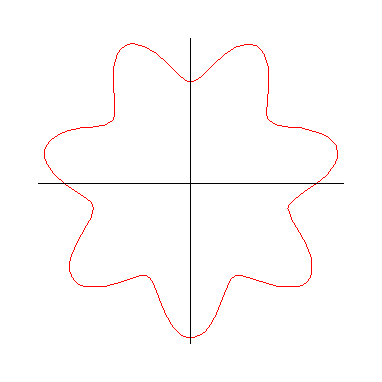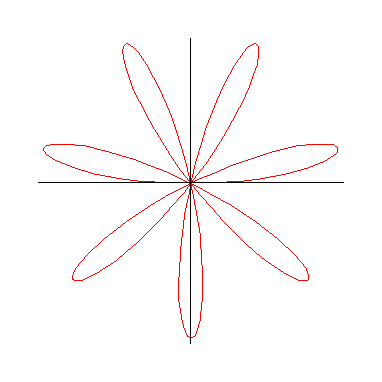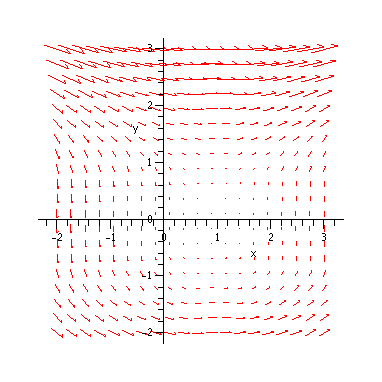
Spring 2010, Math 236
April and May, 2010
Be sure to check back often, because assignments may change!
(Last modified:
Wednesday, April 21, 2010,
9:29 AM )
I'll use Maple syntax for mathematical notation on this page.
All section and page numbers refer to sections from Smith & Minton's Multivariable Calculus, 3rd edition.

Section 12.6: The Gradient and Directional Derivatives (continued)
- To read: Re-read the section.

Section 12.7: Extrema of Functions of Several Variables
- To read: Through example 7.3 (bottom of page 1001)
E-mail Subject Line: Math 236 Your Name 4/5
Reading questions:
- If the partials fx and fy exist everywhere, at what points can f have a local max or a local min?
- Suppose fx(x0, y0)=fy(x0, y0)=0, and at that same point both fxx and fyy are positive (so that in both the x and y direction, f is concave up). Must f have a local min at the point (x0, y0)?
- Suppose that f is a "nice" function, and that the following are true:
- fx(2,-1)=0=fy(2,-1)
- fxx(2,-1)=-1
- fyy(2,-1)=-3
- fxy(2,-1)=2.5
Reminder:
- The next stage of the project is due Wednesday at 3pm.

Section 12.7: Extrema of Functions of Several Variables (continued)
- To read: Finish the section
E-mail Subject Line: Math 236 Your Name 4/7
Reading questions:
- Describe the idea behind the method of steepest ascent in your own words.
Reminder:
- A laptop would be helpful to have in class today.
- Stage 2 of the the project is due Wednesday at 3pm.

Section 13.1: Double Integrals
- To read: All
E-mail Subject Line: Math 236 Your Name 4/9
Reading questions:
- If f(x,y) is a positive function of two variables, what does

 R f(x,y)dA measure?
R f(x,y)dA measure?
- Explain Fubini's Theorem in your own words. What is its importance?
Reminders:
- You don't have a problem set officially due next week because of the exam, but you still should do the problems from Section 13.1 and 13.3 before the exam.

Section 13.1: Double Integrals (continued)
- To read: Re-read the section. Pay careful attention to Example 1.7 -- I know it's at the end of a long section, but it is crucial.
E-mail Subject Line: Math 236 Your Name 4/12
Reading questions:
In the double integral ∫∫R f(x,y)dA,
- What does dA represent?
- Do the two integral signs go together -- that is, are they, in a sense, a new symbol? Or do they represent first one integral and then another?
Reminders:
- No problem set due Friday - study for the in-class exam and do the problems from the most recent sections to prepare for the take-home exam instead.

Exam 2 - In Class Portion
No Reading Questions Today!

Section 9.4: Polar Coordinates
Section 13.3: Double Integrals in Polar Coordinates
- To read: All of Section 9.4 (available through my OnCourse page); through Example 3.2 in Section 13.3.
E-mail Subject Line: Math 236 Your Name 4/16
Reading questions:
- Find rectangular coordinates for the polar point (1,Pi/3).
- Find one polar coordinate representation for the rectangular point (5,-2).
- The graphs of (a) r=sin(7θ) and of (b) r=sin(7θ)+5 are shown below. Match the functions to the graphs.


- polarplot(sin(7*theta),theta=0..Pi);
- polarplot(sin(7*theta)+5, theta=0..2*Pi);

Section 13.3: Double Integrals in Polar Coordinates
- To read: Finish
E-mail Subject Line: Math 236 Your Name 4/19
Reading questions:
- Why might we want to convert a double integral from rectangular coordinates to polar coordinates?
- When we use iterated integrals to evaluate an integral in polar coordinates, what is dA?
Reminders:
- The take-home portion of Exam 2 is due at 8am Tuesday morning.

Section 13.4: Surface Area
- To read: All
E-mail Subject Line: Math 236 Your Name 4/21
Reading questions:
- Give a real-world example where you would want to compute the surface area.
- After partitioning the region R, what objects are used to approximate the surface area over each subregion Ri?
- Where does the cross-product come in?
- What formula from earlier in the semester does the formula for surface area remind you of? Why might these two quantities have similar formulae?
Reminder:
- PS 9 is again a group assignment. Switch partners, don't split the problems up, and put a star next to the primary author's name.

Section 14.1: Vector Fields
- To read: All
E-mail Subject Line: Math 236 Your Name 4/23
Reading questions:
- On page 1118, figures 14.3(a) and 14.3(b) are both representations of the vector field H(x,y)=<y,-x>, yet they look very different. Based on the definition of a vector field, which of these two graphs do you think most correctly shows the vector field? Which one do you think gives you the best feel for the behavior of the vector field?
- Suppose the vector field shown below represents the flow of a small portion of a river, and suppose a leaf were to fall into the water at the point (-2,2). Describe the movement of the leaf.

fieldplot(f(x,y), x=-2..3, y=-2..3, fieldstrength=maximal(2),color=red); - Compare this behavior with the path the leaf would follow if it fell in at the point (-2,2.5) instead.

Section 14.2: Line Integrals
- To read: Through Theorem 2.3, top of page 1136.
E-mail Subject Line: Math 236 Your Name 4/26
Reading questions:
- Give two different uses for line integrals with respect to arc length.
- If you're evaluating a line integral with respect to arclength, does the orientation of the curve matter? If so, what difference does orientation make?
Reminders:
- Your individual project is due Friday -- you should be entering the final stages!

Section 14.2: Line Integrals (continued)
- To read: Finish
E-mail Subject Line: Math 236 Your Name 4/28
Reading questions:
- Give at least one use for component-wise line integrals.
- If you're evaluating a line integral with respect to any of the axes, does orientation matter? If so, what difference does orientation make?

Section 14.3: Independence of Path and Conservative Vector Fields
- To read: All
E-mail Subject Line: Math 236 Your Name 4/30
Reading questions:
- Why are conservative vector fields so helpful when evaluating line integrals?
- Why is Theorem 3.2 called the Fundamental Theorem for line integrals?
Reminders:
- The project is due by 3pm Friday.

Section 14.4: Green's Theorem
- To read: All
E-mail Subject Line: Math 236 Your Name 5/3
Reading questions:
- What surprises you about Green's Theorem?
- Give an example of a region R in the plane where Green's Theorem does not hold.

Section 14.4: Green's Theorem
- To read: Re-read this section, try to pick up on missed subtleties -- this is a very cool and very important theorem!
No Reading Questions Today

Final - In Class Portion
No reading questions today
Janice Sklensky
Wheaton College
Department of Mathematics and Computer Science
Science Center, Room 101A
Norton, Massachusetts 02766-0930
TEL (508) 286-3973
FAX (508) 285-8278
jsklensk@wheatonma.edu
Back to: Multivariable Calculus | My Homepage | Math and CS